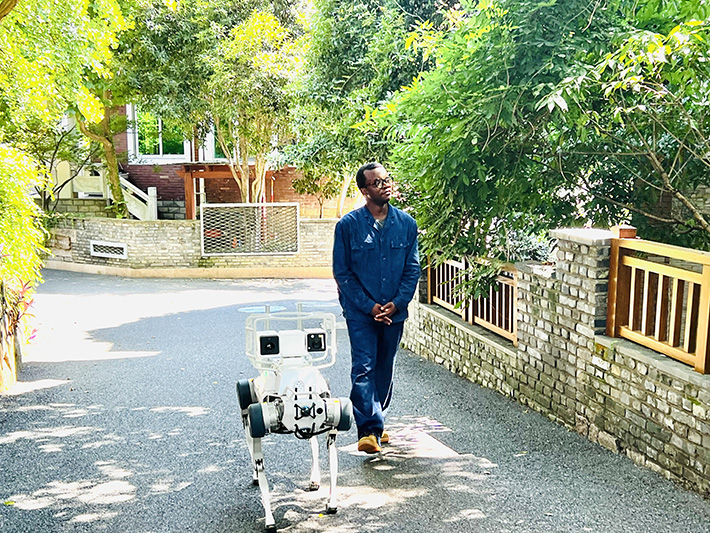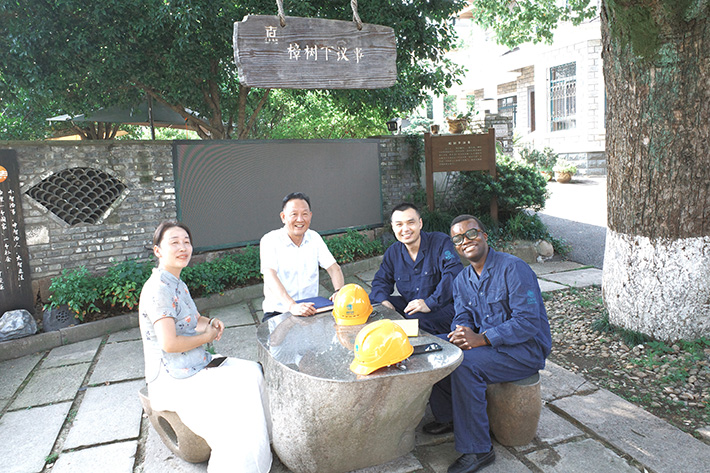|
||||||||||
| Home Top News Economy/Tech Culture/Sports China in Foreign Eyes Green Development Videos Intangible Cultural Heritages |
|
||||||||||
| Home Top News Economy/Tech Culture/Sports China in Foreign Eyes Green Development Videos Intangible Cultural Heritages |
| ChinAfrica |
| Ancient Roots, Modern Wisdom |
| How China’s Two Mountains philosophy can inspire Africa |
| By Joseph Olivier Mendo’o | VOL. 17 October 2025 ·2025-10-10 |

Joseph Olivier Mendo’o walks with a robot dog in Xiaogucheng Village, Hangzhou, Zhejiang Province, in July (COURTESY)
Two decades ago, an important development philosophy emerged that would redefine prosperity: “Lucid waters and lush mountains are invaluable assets.” Known as the “Two Mountains” theory, it challenged the conventional trade-off between development and the environment by arguing that they are inseparable.
I recently visited Zhejiang Province in east China to see how this philosophy works in practice. What I found, beneath the canopy of a 200-year-old camphor tree in Xiaogucheng Village, was a model of green development that seamlessly integrates ancient community dialogue with digital precision, a model highly relevant to Africa’s own sustainable development journey.
The most compelling feature of Xiaogucheng’s grassroots governance is the Big Camphor Tree Meeting. Far from a mere tradition, it functions as a dynamic mechanism for participatory governance. The space around the tree serves as an open-air parliament where grid managers from power, telecom and water sectors set up informal stations each evening. As villagers pass by, they casually report issues, such as a faulty solar panel connection or a vehicle blocking a charging point, kick-starting an efficient problem-resolution process. The grid manager logs each issue into the digital platform called Village Affairs Connect, which automatically dispatches a work order to the nearest available technician or volunteer. Often the problem is solved within minutes.
The practice of governance under the tree illustrates a highly responsive system in which community concerns raised beneath a single tree are transformed into actionable work orders.
A virtuous cycle
This approach creates a self-reinforcing green cycle. By reducing unnecessary travel through data-driven coordination, the system inherently supports low-carbon principles. Prompt and responsive maintenance ensures that green infrastructure such as mobile charging piles, rooftop solar panels and smart metres operate at peak efficiency, which in turn builds community trust. As residents experience reliable and well-managed facilities, their willingness to invest in and adopt eco-friendly practices increases, creating a feedback loop: Greater sustainability leads to greater convenience, which in turn encourages sustainable behaviour.
Xiaogucheng’s success also rests on its allocation of the “three rights,” decision-making, supervision, and benefit-sharing, made tangible through technology via a “green ledger.” Every ecological project, from installing solar panels to upgrading infrastructure, requires approval at the Camphor Tree Meeting.
This grassroots involvement transforms environmental protection from a passive obligation into an active commitment. Annual revenues from rooftop solar and charging piles are distributed to households based on eco-friendly contributions, while tourism income is reinvested in environmental maintenance. The result is a reinforcing cycle: Protection enhances natural beauty, natural beauty generates profit, and profit motivates further protection. In this system, ecology is not a cost, but an appreciating form of “green equity.”

Joseph Olivier Mendo’o experiences the Big Camphor Tree Meeting in Xiaogucheng Village, Hangzhou, Zhejiang Province, in July (COURTESY)
Inspiring model
Africa, with its rich traditions of communal dialogue and pressing development needs, is well positioned to draw inspiration from this model. Many communities across the continent already gather under trees for discussion. By introducing solar-powered digital displays that present real-time data, such as rainfall, soil health, or visitor statistics, these discussions could be enriched, blending traditional wisdom with evidence-based insights.
Well-designed NGO projects often fail due to their top-down approach. Allowing communities to vote on specific, donor-funded initiatives, such as solar lighting, wetland construction or hospitality training, can make project implementation more transparent, accountable, and sustainable.
China integrated environmental costs into project planning from the very beginning. Africa can adopt a similar approach by designing energy systems that prioritise renewable sources from the outset, employing smart grids to automate clean energy use and gradually phase out polluting alternatives.
The 20th anniversary of the Two Mountains theory offers Africa not a rigid blueprint, but an adaptable guide. It demonstrates that prosperity does not require choosing between tradition and technology. The camphor tree symbolises deep-rooted community engagement, while digital tools enable efficient and transparent action.
Africa’s greatest assets include its vibrant communities and natural landscapes. By blending communal values with suitable technology, African nations can chart their own story of development, pursuing development that protects and strengthens natural resources, and guaranteeing sustainability for generations to come.
The author is Head of the African Youth Delegation in China and Ph.D. Student of School of International Studies, Peking University
| About Us | Contact Us | Advertise with Us | Subscribe |
| Copyright Beijing Review All rights reserved 京ICP备08005356号-5 京公网安备110102005860号 |